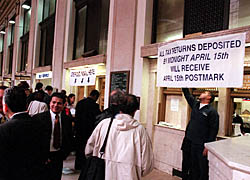
[Home] [ABCNews.com] [ColeGroup] [InfoWorld] [Money] [NYT]
Tax Software: Good Company for a Tough Task
By STEVEN E. BRIER
s if tax forms were not confusing enough, many of the changes made in tax laws several years back did not go into effect until this year, showing up for the first time in the tax forms now piling up in mailboxes.
Jack Manning/The New York Times Some taxpayers will avoid crowds like the one above by going digital.
Overview
• Tax Software: Good Company for a Tough Task
This Week's Reviews
• Turbotax
• Kiplinger's Taxcut
• Taxact
• WintaxRelated Article
It May Still Be Certain, but at Least It's Easier
(January 21, 1999)
Changes like those in the child tax credit, the Roth I.R.A. and education tax incentives; similar changes in the tax laws of many states; the number of people moonlighting, and the effect of stock market volatility on individual portfolios -- things like these have made the traditional way of doing income taxes, sitting down at the dining room table on a winter weekend, seem hopelessly quaint.
Although you can still prepare taxes without anything more than the Internal Revenue Service forms, work sheets and a pencil, more people are turning to outside help.
That outside help ranges from professional tax preparers to desktop software packages and Web sites. Professional tax preparers can offer a level of hand-holding not available from software and the Internet. But they can also be intimidating, and their services typically cost much more than a desktop software package. And for many people, talking about salaries and net worth is something to be done only in the privacy of their own homes.
Another form of professional help, desktop software, is available for those who are comfortable with computers and would rather do their own taxes.
Such packages offer help in the privacy of your home for a reasonable cost. The cost is even more reasonable if you take advantage of the many discounts and rebates available. Most of the companies selling desktop tax software also sell professional versions, and both have the core components that compute taxes. These companies usually offer to pay the penalties if the actual computations are incorrect, a comforting thought when staring at a bewildering array of tax laws.
CONSUMER INFORMATION
Here are some things to consider before buying tax software:
Make sure the software works on your computer.
Many tax packages have demanding system requirements.
Make sure you get all the forms you need.
Make sure the program handles your state returns.
Not all programs handle all states. State software can cost extra.
Look for a program that will import data you already have.
If you used tax software last year or use personal financial software, some programs can make use of that information.
Compare with Web-based programs.
Using the Web to prepare taxes can cost less than using software, but Web software tends to be slower than a desktop package, have fewer features or both.
Never pay list price.
You can save money with discounts and rebates, and it is often cheaper to download software from the Web. You may be able to deduct the cost on next year's return.
By necessity, the full-featured desktop packages lean toward a "one size fits all" approach. They tailor the questions you are asked according to your earlier answers and figure out which I.R.S. forms you need, but it occasionally seems as though you fell through the looking glass as you answer what appears to be the same question for the third time.
An added benefit is that most of the packages offer electronic filing and electronic tax payments, which the I.R.S. is pushing quite hard this year. The tax agency predicts that about 30 million individual tax returns will be filed electronically.
Bob Barr, the assistant I.R.S. commissioner for electronic tax administration, said the agency saw a 10 percent increase in electronic filing last year, to 28 percent. "This year we are projecting a 20 percent increase and crossing our fingers," he said.
The reason to push electronic filing, which the I.R.S. calls the E-file program, can be deduced from simple arithmetic. Every paper return has to be entered by hand into I.R.S. computers, a task that keeps tens of thousands of people busy at 10 regional centers. Electronic returns do not have to be entered by hand.
And electronic returns go through rigorous error checks before they can be transmitted, reducing their error rate to less than 2 percent. For paper returns, that rate is about 20 percent.
Fewer errors mean fewer contacts with the I.R.S. and faster refunds, something to please most taxpayers.
Steven E. Brier is a freelance technology writer based in New Jersey.
